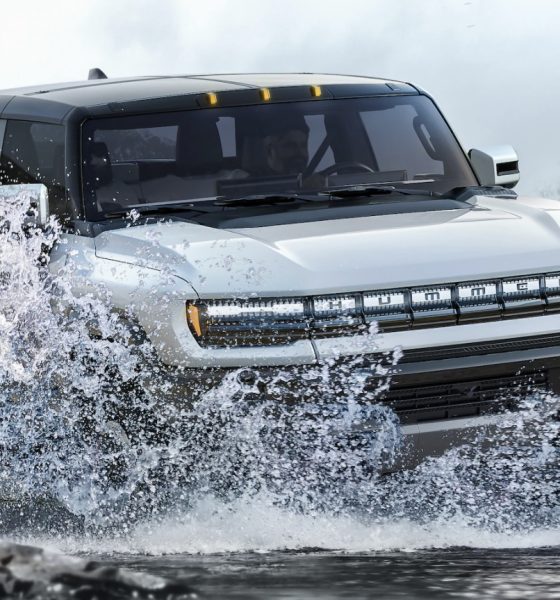General Motors has officially launched the GMC Hummer EV, the veteran automaker’s answer to the Tesla Cybertruck, the Rivian R1T, and the upcoming Ford F-150 Electric. A look at the features and specs of the massive all-electric truck shows that GM means business.
At first glance, the Hummer EV looks every bit like its namesake, which, ironically enough, was one of the vehicles that ushered in the extinction of the EV1, GM’s modern electric car. It’s a behemoth of a vehicle like Hummers of years past, and it exudes toughness from the ground up. The Hummer EV has an intimidating stance, making it evident that GM is looking to establish the vehicle as a formidable force in the all-electric pickup truck market.
The Hummer EV will be offered in four trims: the Edition 1, the EV3X, the EV2X, and the EV2. The rollout of the vehicle will be done in four phases too, with the Edition 1 rolling out next year and the rest of the lineup being released at a later date — some at a significantly later date.

Hummer EV Edition 1
The Hummer EV Edition 1 will be equipped with three electric motors that provide the vehicle with 1,000 horsepower and 11,500 pound-feet of torque. The vehicle is fitted with a 200-kWh Ultium battery pack, giving it an estimated range of over 350 miles per charge. Fast charging is supported up to 350 kW thanks to its 800-volt architecture, allowing the Hummer EV to gain 100 miles of range in just 10 minutes.
Performance-wise, the Hummer EV Edition 1 is not a slouch, with GM stating that the all-electric truck will be capable of going from 0-60 mph in just 3.0 seconds thanks to a driving mode that the veteran automaker calls “Watts to Freedom.” The Hummer EV’s massive size does not mean that it’s not nimble either, with GM releasing the vehicle with 4-wheel steering features and a “Crabwalk” function, which would help the truck navigate tight spaces.
Other unique goodies are available on the Edition 1, which as an “Infinity Roof” with modular, transparent sky panels, unique badging in the interior, and a white exterior.
The Hummer EV Edition 1 starts at $112,595.

Hummer EV3X
After the Edition 1 rolls out next year, the Hummer EV3X will be released in the fall of 2022. The EV3X, just like the Edition 1, will be fitted with three electric motors, but it is estimated to have only 300+ miles of range per charge. While the vehicle is not listed with the Edition 1’s “Watts to Freedom” driving mode, it is still an impressive truck with 800 horsepower and 9,500 lb-ft of torque.
Features like Crabwalk, adaptive air suspension, torque vectoring, “Adrenaline Mode,” 4-wheel steering, and GM’s SuperCruise are standard on the Hummer EV3X.
The Hummer EV3X starts at $99,995.

Hummer EV2X
The Hummer EV2X is expected to be available on Spring 2023. Unlike the EV3X and the Edition 1, the Hummer EV2X will only be equipped with two electric motors that enable 625 horsepower and 7,400 lb-ft of torque. Similar to its EV3X sibling, the EV2X is estimated to have a range of 300+ miles per charge.
The EV2X is still quite robust with features, with still having features like Crabwalk, 4-wheel steering, and an adaptive air suspension system that allows the truck to navigate tricky, off-road terrain. It does, however, not have torque vectoring features.
The Hummer EV2X starts at $89,995.
Hummer EV2
The base Hummer EV2 will not be available until Spring 2024, making it over three years away. Like the EV2X, the EV2 has two electric motors that produce 625 horsepower and 7,400 lb-ft of torque. Despite its entry-level status, the Hummer EV2 is still well-equipped with features as well, including Supercruise, an “Adrenaline Mode” and 22″ wheels with 35″ tires.
The EV2, however, has the least range in the Hummer EV lineup, with the vehicle having a rather conservative 250+ miles of range per charge. It also lacks some key features that make the EV2X, EV3X, and Edition 1 very compelling, such as Crabwalk, adaptive air suspension, and 4-wheel steering.
The base Hummer EV starts at $79,995.
Watch GM’s unveiling of the Hummer EV in the video below.

Elon Musk
Elon Musk and Tesla AI Director share insights after empty driver seat Robotaxi rides
The executives’ unoccupied tests hint at the rapid progress of Tesla’s unsupervised Robotaxi efforts.

Tesla CEO Elon Musk and AI Director Ashok Elluswamy celebrated Christmas Eve by sharing personal experiences with Robotaxi vehicles that had no safety monitor or occupant in the driver’s seat. Musk described the system’s “perfect driving” around Austin, while Elluswamy posted video from the back seat, calling it “an amazing experience.”
The executives’ unoccupied tests hint at the rapid progress of Tesla’s unsupervised Robotaxi efforts.
Elon and Ashok’s firsthand Robotaxi insights
Prior to Musk and the Tesla AI Director’s posts, sightings of unmanned Teslas navigating public roads were widely shared on social media. One such vehicle was spotted in Austin, Texas, which Elon Musk acknowleged by stating that “Testing is underway with no occupants in the car.”
Based on his Christmas Eve post, Musk seemed to have tested an unmanned Tesla himself. “A Tesla with no safety monitor in the car and me sitting in the passenger seat took me all around Austin on Sunday with perfect driving,” Musk wrote in his post.
Elluswamy responded with a 2-minute video showing himself in the rear of an unmanned Tesla. The video featured the vehicle’s empty front seats, as well as its smooth handling through real-world traffic. He captioned his video with the words, “It’s an amazing experience!”
Towards Unsupervised operations
During an xAI Hackathon earlier this month, Elon Musk mentioned that Tesla owed be removing Safety Monitors from its Robotaxis in Austin in just three weeks. “Unsupervised is pretty much solved at this point. So there will be Tesla Robotaxis operating in Austin with no one in them. Not even anyone in the passenger seat in about three weeks,” he said. Musk echoed similar estimates at the 2025 Annual Shareholder Meeting and the Q3 2025 earnings call.
Considering the insights that were posted Musk and Elluswamy, it does appear that Tesla is working hard towards operating its Robotaxis with no safety monitors. This is quite impressive considering that the service was launched just earlier this year.
Elon Musk
Starlink passes 9 million active customers just weeks after hitting 8 million
The milestone highlights the accelerating growth of Starlink, which has now been adding over 20,000 new users per day.

SpaceX’s Starlink satellite internet service has continued its rapid global expansion, surpassing 9 million active customers just weeks after crossing the 8 million mark.
The milestone highlights the accelerating growth of Starlink, which has now been adding over 20,000 new users per day.
9 million customers
In a post on X, SpaceX stated that Starlink now serves over 9 million active users across 155 countries, territories, and markets. The company reached 8 million customers in early November, meaning it added roughly 1 million subscribers in under seven weeks, or about 21,275 new users on average per day.
“Starlink is connecting more than 9M active customers with high-speed internet across 155 countries, territories, and many other markets,” Starlink wrote in a post on its official X account. SpaceX President Gwynne Shotwell also celebrated the milestone on X. “A huge thank you to all of our customers and congrats to the Starlink team for such an incredible product,” she wrote.
That growth rate reflects both rising demand for broadband in underserved regions and Starlink’s expanding satellite constellation, which now includes more than 9,000 low-Earth-orbit satellites designed to deliver high-speed, low-latency internet worldwide.
Starlink’s momentum
Starlink’s momentum has been building up. SpaceX reported 4.6 million Starlink customers in December 2024, followed by 7 million by August 2025, and 8 million customers in November. Independent data also suggests Starlink usage is rising sharply, with Cloudflare reporting that global web traffic from Starlink users more than doubled in 2025, as noted in an Insider report.
Starlink’s momentum is increasingly tied to SpaceX’s broader financial outlook. Elon Musk has said the satellite network is “by far” the company’s largest revenue driver, and reports suggest SpaceX may be positioning itself for an initial public offering as soon as next year, with valuations estimated as high as $1.5 trillion. Musk has also suggested in the past that Starlink could have its own IPO in the future.
News
NVIDIA Director of Robotics: Tesla FSD v14 is the first AI to pass the “Physical Turing Test”
After testing FSD v14, Fan stated that his experience with FSD felt magical at first, but it soon started to feel like a routine.

NVIDIA Director of Robotics Jim Fan has praised Tesla’s Full Self-Driving (Supervised) v14 as the first AI to pass what he described as a “Physical Turing Test.”
After testing FSD v14, Fan stated that his experience with FSD felt magical at first, but it soon started to feel like a routine. And just like smartphones today, removing it now would “actively hurt.”
Jim Fan’s hands-on FSD v14 impressions
Fan, a leading researcher in embodied AI who is currently solving Physical AI at NVIDIA and spearheading the company’s Project GR00T initiative, noted that he actually was late to the Tesla game. He was, however, one of the first to try out FSD v14.
“I was very late to own a Tesla but among the earliest to try out FSD v14. It’s perhaps the first time I experience an AI that passes the Physical Turing Test: after a long day at work, you press a button, lay back, and couldn’t tell if a neural net or a human drove you home,” Fan wrote in a post on X.
Fan added: “Despite knowing exactly how robot learning works, I still find it magical watching the steering wheel turn by itself. First it feels surreal, next it becomes routine. Then, like the smartphone, taking it away actively hurts. This is how humanity gets rewired and glued to god-like technologies.”
The Physical Turing Test
The original Turing Test was conceived by Alan Turing in 1950, and it was aimed at determining if a machine could exhibit behavior that is equivalent to or indistinguishable from a human. By focusing on text-based conversations, the original Turing Test set a high bar for natural language processing and machine learning.
This test has been passed by today’s large language models. However, the capability to converse in a humanlike manner is a completely different challenge from performing real-world problem-solving or physical interactions. Thus, Fan introduced the Physical Turing Test, which challenges AI systems to demonstrate intelligence through physical actions.
Based on Fan’s comments, Tesla has demonstrated these intelligent physical actions with FSD v14. Elon Musk agreed with the NVIDIA executive, stating in a post on X that with FSD v14, “you can sense the sentience maturing.” Musk also praised Tesla AI, calling it the best “real-world AI” today.










